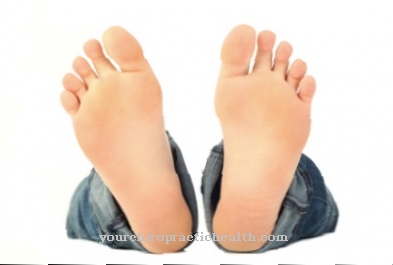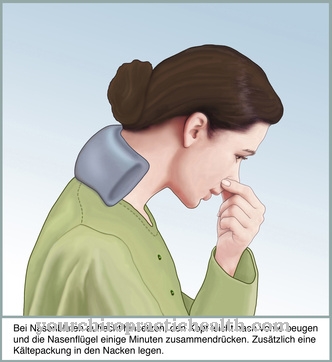Fluid in the knee is a physical complaint shared by many people. At a higher stage, it can lead to a considerable reduction in the ability to walk and stand.
What is fluid in the knee?

Colloquially, the expression "fluid in the knee" is widely used. This includes a number of diseases that contribute to fluid build-up in the knee area.
In medical terminology, the term knee joint effusion is mainly used. In the case of a knee joint effusion, externally visible changes can be perceived in the affected knee joint. This is accompanied by internal deformations. The fluid consists of a pus-like consistency (pyarthrosis), from the body's own joint fluid (synovial fluid) or from blood (hemarthrosis).
It should be noted that the accumulation of fluid is not a disease, but a symptom. In general, a distinction can be made between an acute and a chronic complaint. The former occurs in all age groups, whereas a chronic course predominantly develops in older people.
Individual forms of fluid build-up are also diagnosed among professional athletes. The knee joint effusion can be attributed to excessive stress and the associated knee injuries.
causes
Fluid in the knee is always a side effect. Acute knee joint effusions are caused by trauma as a result of an injury. Examples of this are a cruciate ligament tear, a patellar dislocation, an osteochondral fracture or a fracture of the tibial plateau.
In rare cases, a peripheral meniscus lesion may be the cause of temporary fluid retention. A frequent trigger of a chronic course is excessive irritation of the synovial membrane. It leads to an increased production of the synovial fluid (synovia). In medicine, meniscus lesions, patellar tendon tendonitis and plica syndrome are also known to be other causes.
In these cases, an imbalance between production and absorption is noted. The result is a build-up of fluid in the knee joint capsule. In rare cases, fluid in the knee is caused by an infection. With an inflammatory reaction, the fluid absorption is hindered, which results in a steady accumulation of fluid. Finally, rheumatic diseases and osteoarthritis can be suggested as possible causes.
You can find your medication here
➔ Medicines for joint painDiseases with this symptom
- arthrosis
- Cruciate ligament tear
- Patellar luxation
- Meniscal injuries
- Osteoarthritis of the knee
- Patellar fracture
Diagnosis & course
Knee swelling is the first sign that fluid has built up in the knee. The knee assumes an atypical shape, which is accompanied by a continuous increase in size. This is accompanied by a restriction in mobility and partial stiffness.
Pain is felt under high pressure and worsens as the disease progresses. If there is any suspicion that fluid has accumulated in the knee, a general practitioner or an orthopedic surgeon should be consulted. The doctor begins with a medical history, which focuses on the physical condition. The physical examination plays an important role. The "dancing patella" (kneecap) is checked for functionality.
Attached, the knee is analyzed using ultrasound, X-rays and computed tomography. If an infection is suspected, a microbiological examination can be performed. The liquid is removed with a puncture and checked for a possible pathogen.
Complications
If there is a fluid-filled protuberance in the hollow of the knee, it is a Baker's cyst, which leads to complications when it presses on nerves and blood vessels. In most cases, knee swelling is a complication.
In addition, the Baker's cyst can rupture, i.e. tear, due to excessive growth and excessive pressure during knee flexion. Because the synovia then exits into the surrounding tissue, inflammation and even greater pain often occur. Due to gravity, the synovial fluid flows into the muscles of the lower leg and sometimes even into the ankle area, where pressure builds up that cannot escape. The compartment syndrome occurs. This exerts pressure on the nerves and blood vessels and may lead to a lower leg amputation if surgical treatment is not performed in good time.
If the knee joint is punctured to remove the fluid, the knee joint may refill with synovia and swell after a temporary improvement.
If the necessary surgical treatment, minimally invasive, by means of jointoscopy or openly, is delayed too long, cartilage damage or damage to the menisci cannot be ruled out. This risk is increased with rheumatoid arthritis as the cause.
If inflammation (arthritis) occurs in the knee joint due to microorganisms (viruses or bacteria), cells and tissue can be damaged and the joint elements can die. This condition, which also leads to a reduction in the general condition, can arise preoperatively but also postoperatively.
When should you go to the doctor?
Liquid in the knee or, to put it casually, "water in the knee" is always a reason to see a doctor. The phenomenon, also known as knee joint effusion, is a symptom of several diseases. The fluid in the knee is either synovial fluid, a purulent secretion or blood. There are acute and chronic variants of fluid in the knee. While acute knee joint effusion occurs in all age groups, chronic joint effusion mainly affects older people. Fluid in the knee is also occasionally found in professional athletes.
Anyone who notices swelling in one or both knees should see a doctor immediately. Swelling around the knees indicates fluid retention. There are several possible causes of fluid in the knee. The earlier medical treatment starts, the better. Doctors can use numerous diagnostic methods. X-rays, ultrasound and computed tomography are common examination methods for fluid in the knee. If the examination result indicates an infection, a knee puncture follows, in which the doctor takes some of the fluid in the knee in order to examine it microbiologically.
When there is fluid in the knee, the time saved counts. An early visit to the doctor and the start of treatment can help prevent a lengthy and painful course of treatment. At the end of the treatment, the doctor can prescribe physiotherapy for the patient to regenerate the traumatized knee joint.
Doctors & therapists in your area
Treatment & Therapy
After a diagnosis, the doctor decides which therapy should be initiated. The treatment is usually causal. Accordingly, the cause is treated so that the fluid in the knee can decrease in the long term.
If an effusion of the knee joint is the result of trauma, the aim is to immobilize the knee. First and foremost, it is important to treat the injury. On the other hand, chronic courses are accompanied by medication, while an infection is treated with antibiotics. In severe cases, it is necessary to operate on the knee. It is no longer necessary to open the entire knee.
Instead, small areas are punctured, after which the fluid is suctioned off. The aim of the surgical procedure is to reduce the accumulated fluid in the knee in order to relieve the pressure. However, it is often possible to eliminate the swelling by immobilizing the knee joint. Elevating the extremity also provides relief.
If necessary, this can be accompanied by therapeutic intervention in the form of a joint puncture. Herbal and homeopathic remedies finally round off a treatment. In retrospect, physiotherapy is recommended to regenerate the knee joint after the fluid in the knee has largely decreased.
Outlook & forecast
Fluid in the knee does not always lead to particular complaints or complications. The causes and complaints are, however, relatively different. In most cases, fluid develops in the knee due to inflammation, such as a cruciate ligament tear. If this injury does not heal properly, the fluid can build up. This is especially the case if the leg continues to be heavily loaded. There may be severe pain and restricted mobility due to the fluid retention.
Osteoarthritis can also be responsible for the fluid in the knee. This also leads to pain and movement restrictions. The quality of life decreases in most cases.
The treatment is primarily causal and primarily aims to cure the underlying disease. If this is healed, the fluid in the knee usually disappears by itself and there are no further symptoms. It is not uncommon for drugs to be used to prevent or treat inflammation. In severe cases, the liquid can also be removed directly by the doctor. Furthermore, there are no restrictions or complaints for the patient.
You can find your medication here
➔ Medicines for joint painprevention
With preventive measures it is possible at any age to reduce the risk of a knee joint effusion. It is particularly important to avoid excessive strain on the knee through sporting activities.
The best-known high-risk sports include squash and skiing. These sports should only be practiced in moderation. At the same time, it is recommended to strengthen muscles, tendons and ligaments. Jogging, swimming, and stretching can help with this.
If a knee injury has already been suffered, a therapeutic measure for regeneration and stabilization can be carried out. This will reduce the risk of relapse. It may even be advisable to start physiotherapy.
























.jpg)



